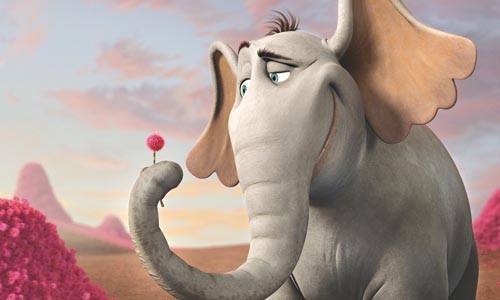Ah, Horton. That big-hearted -- and just all 'round big -- hero of Dr. Seuss' kiddie story Horton Hears a Who, the elephant who faced down an entire jungle to protect a teeny-tiny community and, in doing so, taught everybody a lesson.
It's always risky when filmmakers transform a childhood classic -- especially one of so few words -- into a full-length film. And any Dr. Seuss fan is bound to be sensitive following the last two big-screen outings, The Cat in the Hat and How the Grinch Stole Christmas, both of which I found nearly unwatchable.
So let's say I approached Jimmy Hayward and Steve Martino's computer-animated version of Horton with some trepidation -- and left mostly satisfied. Fortunately, the filmmakers have adhered closely to the original story, stretching out the narrative mostly with related padding rather than appending new plots.
Cheerful elephant Horton lives in the Jungle of Nool, when one day he hears the tiniest cry coming from an airborne speck. Intrigued, he catches the speck on a clover flower and trains his very big ear on the voice. He's delighted to learn he's communicating with the mayor of Whoville, an entire community living somewhere on the speck.
Horton's jungle neighbors, led by the closed-minded and domineering Kangaroo, are not charmed by his discovery. "If you can't see it, hear it or feel it, it doesn't exist," Kangaroo states, and acknowledging otherwise will only cause trouble.
Concerned, Horton, with the flower securely gripped in his trunk, sets out to find his wee new pals a safe harbor, while being pursued by Kangaroo's hired hitman, the black eagle Vlad.
Meanwhile, in Whoville, residents carry on, blissfully unaware how imperiled their whole world is. It's here that the film adds the most extra material. Beside the mayor, we meet his wife, his 96 (!) daughters and his one gloomy, emo-ish son named JoJo. There's a city council, a dentist, a sassy secretary, a scientist and so on -- characters written, I suspect, as much to stretch the tale as to give cameos to comic actors.
Jim Carrey leads the voice actors as Horton, and at times, he's distracting: We hear wisecracking Carrey rather than Horton. Steve Carell steps in as the frazzled mayor of Whoville, and tip-top vet Carol Burnett, without any unnecessary histrionics, transforms Kangaroo into that most recognizable of fearsome adults: the humorless mom.
While dense and colorful, the film takes its look directly from Seuss' own distinctive illustrations. The animated jungle scenes are adequate: They look great but aren't anything that will dazzle you with technique or artistic vision. Whoville, on the other hand, seems to have been waiting all these years to be meticulously brought to life by computer animation. The film's illusion of three dimensions adds immeasurably to the sweet oddness of the Whos' off-kilter structures.
But in the complaint department: If you're going to commit to staying faithful to the story, why break the vibe with jokes about Henry Kissinger, Apocalypse Now and MySpace? I don't buy the argument that accompanying adults have to be placated, particularly with this time-honored work. Dr. Seuss' oeuvre charms because it's wholly original, whereas adding Kennedy jokes to Horton bespeaks of the filmmakers' laziness. Seuss didn't have to be derivative to win over parents -- why should they?
The filmmakers do better by including the few sly winks to the Seuss-iverse: on one child's plate, green eggs and ham; in another scene, the fish from The Cat in the Hat. However, an homage to the ballet-dancing elephant in Disney's Fantasia is ruined by adding some hip-hop booty-shaking. (Yes, kids will laugh at the ass antics, but is there any harm in keeping a moment simply sweet?)
But given the abject cravenness of so many kiddie films these days, Horton, like its stalwart hero, mostly stands its ground. It adds slapstick and some coming-to-a-toy-store-near-you creatures to help keep the kids engaged, but importantly, the film takes care not to gild the "message" lily. Seuss skillfully wove several valuable lessons about faith, tolerance, community and humanity (albeit between animals and whatever Whos are) into his slender story, and the film retains their palatable simplicity.
And boy, are they enduring. No sooner had the film started, when from centuries deep within my cluttered brain, surfaced the story's lilting refrain of acceptance: "A person's a person no matter how small." Worth remembering.
















